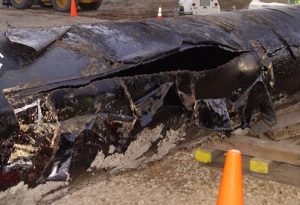Oil on the Kalamazoo
In late 2010, I was returning from the second of two large concurrent U.S. oil spills. In another post, you read about efforts to prepare the Florida Keys for Deepwater Horizon oil, the first of the two. That spill overshadowed the second – the Enbridge Energy pipeline release.
On July 25, 2010 Enbridge’s 30-inch diameter Line 6B ruptured, sending approximately one million gallons of Canadian tar sand oil down a small creek and into the Kalamazoo River. Of course it happened at night, during flood conditions and in a mostly rural and remote setting, adding to the “worst case scenario” character of the event.
I left Key West for Marshall, Michigan to support the response effort as the Planning Section Chief for Enbridge. This was to be the largest inland oil spill in Midwest history, and neither Enbridge nor the U.S. EPA personnel in that region had strong oil spill experience. My experience as a former EPA Federal On-Scene Coordinator was going to prove critical to translating between the parties and anticipating issues. There were many, including strict EPA deadlines to conclude operations quickly while not using intrusive or destructive methods inherent to oil spill response – excavation, burning, chemical countermeasures, dredging and similar. These constraints made it nearly impossible to achieve any measurable success early on, but eventually more aggressive methods were implemented, while still making every effort to protect the integrity of the river system.
About 35 miles of river and floodplain got oiled, along with a fair amount of wildlife. This “heavy” Canadian oil is made flowable in the pipeline by the addition of diluent (solvent). Once out of the pipe, however, the diluent went quickly to the atmosphere leaving a thick tar-like residual, much of which we eventually found on the bottom of the river. “Submerged oil” like this was a first for the response community and caused problems for years for recovery teams tasked with finding and removing it.
Costs for the Enbridge response reportedly hit $1.5 billion. That’s a relatively high $1,500 per gallon spilled. For perspective, consider that BP spent $195 per gallon on the Deepwater release. Murphy Oil (following Hurricane Katrina) cost $410 per gallon, and Exxon Valdez went for $573 per gallon. In the 2011 Exxon “Silvertip” release in Montana, though only around 42,000 gallons, Exxon spent $3,214 per gallon, partially because the corrective action required relocating the pipeline. The lesson here is that it’s not the volume of the spill that drives the cost. As with real estate, it’s all about the location.
But the high cost to Enbridge is not all attributable to the remote river system or the peculiarities of Canadian oil. For example, the NTSB investigation found that it was 17 hours before the release was discovered and that 81% of the spilled oil left the pipeline after it should have been shut down. Other identified failings were no less damning – “a complete breakdown of safety at Enbridge,” “a culture of deviance” and “their employees performed like Keystone Kops…”
Related to the actual responses activities, NTSB determined that Enbridge failed to have an adequate number of well-trained responders and resources available at the time of the release. The response plan, though later deemed “deficient,” was approved by PHMSA (the regulatory body for oil pipelines). The problem was that estimates of time, personnel and resources under those rules are subjective and absent experience, the tendency on both sides is to estimate low and feel confidant of success.
Not in the NTSB report was that Enbridge did not understand the rules of engagement with EPA, namely the formal use of the Incident Command System (ICS) and the requirements of the National Contingency Plans (NCP). To be clear, they were never unwilling; they just did not know the rules. In my response management classes you will hear this lesson preached all the way through as Rule #1: you and your OSROs (response contractors) must speak fluent ICS and NCP. Otherwise you will immediately lose control of your response. If in doubt, ask Enbridge.
The good news is that we see a million gallon spill only every three years or so on average. The bad news is that this lack of spills creates a lack of experience. The only substitute is frank and critical review of plans and realistic exercises to test them. No pretending that everything will work well or that “it” won’t happen. When you’ve done the real thing many times, it’s easy to see the ones who are faking it and where they are going to fail. They’ll be the next big story. Not so much the spill, but about how they didn’t see it coming and refused to learn the lessons from the Enbridge report.

